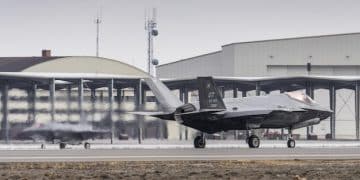US Defense Spending Hike 2025: Alliance Impacts Explored

The projected 15% increase in US defense spending for 2025 is anticipated to significantly reshape global military alliances, strengthening some partnerships while potentially straining others through perceived American unilateralism or increased demands for burden-sharing.
In an era defined by geopolitical fluidity and escalating security concerns, the anticipated 15% increase in US defense spending for 2025 stands as a pivotal development. This substantial financial commitment is not merely an internal fiscal adjustment; it promises to send ripples across the intricate web of established and burgeoning global military alliances, potentially redefining strategic partnerships and deterrence postures worldwide. The implications extend far beyond budget line items, touching upon issues of burden-sharing, technological superiority, and the very architecture of international security.
Understanding the US Defense Budget Increase
The United States consistently maintains the largest defense budget globally, a reflection of its expansive security interests and its role as a leading major power. A projected 15% increase in 2025, if realized, would push this figure to unprecedented levels, signaling a renewed commitment to military modernization, readiness, and power projection. This isn’t just about raw numbers; it’s about what those numbers represent in terms of strategic priorities and operational capabilities.
Such an increase is typically driven by a confluence of factors, ranging from evolving geopolitical threats to domestic economic considerations. For instance, heightened tensions in the Indo-Pacific, ongoing conflicts in Eastern Europe, and the persistent threat of terrorism all contribute to the rationale for bolstering defense capabilities. Furthermore, internal pressures from the defense industrial complex and a desire to maintain a technological edge over potential adversaries play significant roles.
Drivers and Justifications for Increased Spending
Several key factors underpin the likely justification for a substantial boost in military expenditure. These aren’t isolated elements but rather interconnected forces shaping Washington’s strategic calculus.
- Geopolitical Volatility: The current global landscape is marked by conflicts and rivalries not seen in decades. This requires constant adaptation and strengthening of defense postures.
- Technological Race: Maintaining superiority in emerging areas like AI, cyber warfare, hypersonic weapons, and space-based capabilities demands significant investment.
- Modernization Needs: Much of the existing US military hardware requires upgrading or replacement to meet modern combat requirements and sustain operational effectiveness.
- Force Readiness: Ensuring personnel training, equipment maintenance, and logistical support are at peak levels to respond to contingencies anywhere in the world.
The perceived need for a robust defense strategy often outweighs other domestic considerations, particularly when national security is framed as being at stake. It’s a complex interplay of deterrence, defense, and the protection of national interests that underpins these massive investments.
An increased budget also allows for greater flexibility in responding to unforeseen crises. It provides the resources to accelerate research and development, procure new weapon systems, and expand military presence in critical regions. This proactive approach aims to deter aggression and reassure allies, thereby shaping the international security environment in line with US strategic objectives.
Impact on NATO: Burden-Sharing and Strategic Alignment
The North Atlantic Treaty Organization (NATO) stands as the cornerstone of transatlantic security, and any significant shift in US defense policy inevitably reverberates across its member states. A 15% increase in US spending will undoubtedly intensify existing debates about burden-sharing and the alliance’s strategic direction, potentially leading to both strengthened ties and new frictions.
On one hand, a more financially robust US military could reassure European allies, particularly those on the eastern flank, of America’s unwavering commitment to collective defense. This enhanced capability could be seen as a strong deterrent against potential aggressors, providing a sense of security and stability within the alliance. However, this reassurance may come with increased expectations.
Increased Expectations for European Allies
For years, the US has urged NATO members, particularly those in Europe, to meet or exceed the agreed-upon target of spending 2% of their GDP on defense. A substantial increase in US spending will likely amplify these calls, with Washington potentially demanding greater contributions and commitments from its partners. This could manifest in several ways:
- Higher Defense Spending Targets: The 2% GDP target might be re-evaluated, with pressure to increase it or adherence to it becoming non-negotiable.
- Greater Specialization: European nations might be pressured to specialize in certain military capabilities, thus contributing more effectively to collective defense rather than maintaining redundant forces.
- Direct Contributions: Increased funding or material support for joint operations and infrastructure projects might be explicitly requested from European capitals.
This dynamic creates a delicate balance. While some European nations, particularly those most exposed to immediate threats, might welcome a stronger US presence and increased investment, others might view it as an overbearing demand for more resources that they are either unwilling or unable to provide, leading to internal strains within the alliance.
The conversation around burden-sharing is not new to NATO, but the scale of a 15% increase in US defense spending could give it renewed urgency and a sharper edge. The outcome will depend heavily on diplomatic navigation and the willingness of all members to adapt to evolving security imperatives while maintaining alliance cohesion.

Shifting Dynamics in the Indo-Pacific
Beyond traditional alliances, the Indo-Pacific region represents a critical theater for US strategic interests. A significant increase in defense spending will inevitably have profound implications for its existing partnerships and the broader regional security architecture. The focus here is primarily on countering rising powers and maintaining freedom of navigation, but the execution of these objectives will interact with numerous sovereign nations.
Countries like Japan, South Korea, and Australia, key US allies, will observe this development with keen interest. A bolstered US defense capacity could translate into more frequent joint exercises, enhanced intelligence sharing, and potentially, increased American military presence in the region. This might be seen as a welcome development by these allies, providing a stronger deterrent against regional threats.
However, the nature of these alliances could also evolve. The US might seek to deepen interoperability and integrate allied forces more cohesively into its strategic planning. This could involve promoting standardization of equipment, shared doctrinal development, and even integrated command structures for certain operational contingencies. Such moves aim to present a united front, but also require significant political will and trust among partners.
Reinforcing QUAD and AUKUS Initiatives
The Quadrilateral Security Dialogue (QUAD) — comprising the US, Japan, Australia, and India — and the AUKUS security pact between Australia, the UK, and the US, are relatively newer structures designed to enhance security cooperation in the Indo-Pacific. A surge in US defense funding will undoubtedly provide impetus to these initiatives.
- Enhanced Naval Presence: Increased spending can fund more robust naval deployments, crucial for maintaining maritime security and freedom of navigation, particularly in contested waters.
- Advanced Technology Sharing: Funding might accelerate the development and sharing of critical defense technologies within these frameworks, such as submarine technology for AUKUS or advanced ISR capabilities for the QUAD.
- Joint Training and Exercises: More resources would allow for expanded, higher-frequency, and more complex joint military exercises, strengthening interoperability and readiness among partners.
These initiatives, while aimed at bolstering regional security, also send strong signals to other actors in the region, particularly those perceived as potential adversaries. The US defense budget increase would empower these alliances, making them more formidable and capable, but also potentially heightening strategic competition.
The impact will be multilateral, influencing not just direct security partners but also non-aligned nations in the region. Their reactions could range from seeking closer ties with the US and its allies to pursuing independent defense buildups, reflecting the intricate geopolitical balancing act inherent in the Indo-Pacific.
Middle East Realignments: Balancing Commitments
The Middle East has long been a complex arena for US foreign policy, characterized by shifting alliances, regional rivalries, and persistent security challenges. A 15% increase in US defense spending for 2025 will inevitably lead to a recalibration of Washington’s commitments and strategies in the region, affecting its traditional partners and rival powers alike.
For decades, the US has maintained a significant military presence in the Middle East, primarily focused on counter-terrorism, securing vital energy supplies, and deterring state-sponsored aggression. Increased funding would allow for reinforcing these objectives or, alternatively, for strategically re-evaluating the allocation of resources. This comes at a time when several regional powers are actively pursuing their own agendas and developing their military capabilities.
Evolving US Presence and Partnerships
The US is continuously balancing its interests in the Middle East with its broader global strategic priorities. An influx of defense funds will enable more flexibility in this complex balancing act:
- Enhanced Security Assistance: Traditional allies such as Saudi Arabia, the UAE, and potentially Israel could see an increase in security assistance, arms sales, and joint training programs, solidifying existing partnerships.
- Counter-Terrorism Efforts: Resources could be re-directed or amplified to combat persistent extremist threats, possibly through increased intelligence sharing and special operations support to local forces.
- Deterrence Posture: A more robust US defense budget allows for projecting greater power, potentially deterring actions by hostile state and non-state actors through increased naval patrols, air deployments, and ground presence exercises.
However, a greater US capability might also lead to renewed calls for regional burden-sharing or even to a more selective engagement strategy. Washington might expect its partners to assume greater responsibility for their own security, while the US focuses on providing high-end capabilities and strategic oversight. This shift requires careful diplomatic handling, as regional actors each have their own security concerns and strategic interests, which do not always align perfectly with American objectives.
The long-term impact on Middle Eastern alliances will depend on how the US leverages its increased spending: whether it chooses to deepen military integration, maintain a steady-state presence, or strategically pivot resources to other pressing global theaters while still ensuring regional stability through indirect means.
Implications for Non-Aligned Nations and Emerging Powers
The ripple effects of a significant increase in US defense spending extend beyond its immediate allies, influencing the strategic calculus of non-aligned nations and emerging powers across the globe. These countries, while not formally bound by treaty obligations, are integral to the international system and their responses will shape the future geopolitical landscape.
Many non-aligned states often seek to maintain a delicate balance between major powers, leveraging their neutrality to pursue independent foreign policies. A stronger US military posture could compel some to re-evaluate their positions. They might perceive an increased need to align, at least partially, with either the US or its rivals, or to bolster their own defense capabilities to preserve their autonomy.
Emerging powers, such as India, Brazil, and South Africa, also play a crucial role. They are increasingly assertive on the global stage and their foreign and defense policies are often driven by a combination of national interest, regional dynamics, and a desire for greater international influence. The US defense spending surge will be factored into their strategic assessments.
Strategic Realignments and Independent Buildups
The projected increase can prompt diverse reactions among these nations, leading to complex and sometimes contradictory outcomes.
- Seeking Security Guarantees: Some non-aligned nations, feeling more vulnerable, might subtly seek closer security ties or guarantees from the US or its allies, albeit without formalizing a full alliance.
- Accelerated Indigenous Defense: Other countries might see the US expenditure as part of a broader militarization trend, prompting them to invest more heavily in their own defense industries and capabilities to reduce external reliance.
- Diversifying Partnerships: Nations might intensify efforts to diversify their military suppliers and strategic partners, cultivating relationships with multiple global powers to avoid over-reliance on any single entity.
The arms trade, in particular, is likely to be impacted. Non-aligned nations may seek to acquire more advanced military technologies, potentially leading to increased competition among major arms exporters. The US, with its enhanced budget, might also offer more attractive defense packages, swaying procurement decisions.
Ultimately, the responses of these countries will contribute to a more dynamic and potentially more fragmented global security environment. Each nation will weigh its own security concerns, economic capacities, and geopolitical aspirations in deciding how to navigate a world with an even more dominant US military force.

The Economic and Technological Dimension of Alliances
Military alliances are not solely defined by shared security threats or interoperability on the battlefield; they are increasingly interwoven with economic and technological cooperation. The projected 15% increase in US defense spending for 2025 will profoundly influence these dimensions, acting as both a catalyst for collaboration and a potential source of friction.
Economic considerations, such as arms sales, defense industrial base integration, and joint research and development, form the bedrock of many strategic relationships. A larger US defense budget means more procurement, more R&D, and potentially more opportunities for allied industries to participate in lucrative defense contracts. This can deepen economic interdependence and bolster military partnerships.
Technologically, the US continues to be a leader in military innovation. Increased spending allows for accelerated development of cutting-edge systems, from AI-powered autonomous weapons to advanced cybersecurity solutions. Allies are keen to access these technologies, which are vital for maintaining a competitive edge and ensuring their own national security.
R&D, Joint Ventures, and Arms Transfers
The financial injection into the US defense apparatus will likely drive several key trends:
- Increased R&D Collaboration: The US might initiate more joint research and development projects with key allies, particularly in areas like advanced materials, quantum computing for defense, and integrated sensing systems, thereby sharing the costs and expertise.
- Enhanced Defense Industrial Base Integration: More US contracts could be opened to allied defense companies, fostering greater interdependence and creating a more resilient, distributed defense supply chain across alliance partners.
- Strategic Arms Transfers: With a stronger financial footing, the US might be more willing or able to transfer advanced military equipment and technology to allies, helping them modernize their forces and improve interoperability.
However, this also brings challenges. Technology transfer is often fraught with concerns over intellectual property, security risks, and maintaining a competitive advantage. The US will need to carefully navigate which technologies to share and with whom, ensuring that such transfers align with strategic goals without compromising its own long-term interests.
Moreover, smaller allies might find it difficult to keep pace with the technological sophistication and economic demands of a rapidly modernizing US military. This could create a two-tiered system within alliances, where some partners are more deeply integrated than others, potentially impacting alliance cohesion and the principle of collective defense.
The economic and technological dimensions underscore that military alliances are multifaceted. The spending increase will compel allies to consider not just their military compatibility but also their economic and technological alignment with the US.
Potential for Unintended Consequences and Challenges
While an increase in US defense spending is often framed in terms of enhancing security and stability, it is imperative to consider the potential for unintended consequences and the challenges it might pose to global military alliances. Geopolitical dynamics are rarely linear, and even well-intentioned policy shifts can have complex, unforeseen repercussions.
One primary concern revolves around the perception of American unilateralism. Despite rhetoric emphasizing alliance strength, a significant, unilateral boost in US military might could be interpreted by some allies as Washington re-asserting its independence from multilateral frameworks. This could lead to feelings of marginalization or a belief that their contributions are less valued, potentially straining alliance bonds.
Furthermore, an aggressive defense buildup can inadvertently fuel an arms race, prompting rival powers to increase their own military expenditures. This escalatory cycle can lead to greater instability, heightening tensions and increasing the risk of miscalculation. The security dilemma suggests that one nation’s efforts to enhance its security can inherently decrease the security of others, leading to a vicious cycle of arms buildups.
Risks and Disruptions to Global Stability
The projected spending increase, while aimed at bolstering US security interests, also carries inherent risks that could disrupt rather than strengthen global stability and alliance structures.
- Alliance Strain: Disagreements over strategic priorities or a perceived lack of consultation could strain relationships with allies who feel their voices are not adequately heard in Washington’s defense planning.
- Escalation of Tensions: A more assertive US military posture, backed by increased funding, could lead to a more aggressive response from adversarial nations, intensifying existing geopolitical flashpoints.
- Economic Burden on Allies: Pressure on allies to increase their own defense spending to match US expectations could place unsustainable economic burdens on some nations, exacerbating internal political or economic challenges.
- Diversion of Resources: Even within the US, a massive defense budget increase could divert resources from other critical areas, such as diplomacy, development aid, or addressing climate change, potentially undermining non-military tools of international influence.
Moreover, the focus on military solutions might inadvertently overshadow diplomatic efforts. A heavily resourced military can sometimes lead to a preference for coercive strategies over cooperative ones, which might alienate potential partners and undermine the soft power aspects of US foreign policy.
Navigating these challenges will require not only military prowess but also astute diplomacy, clear communication with allies, and a willingness to engage in genuine burden-sharing discussions that consider the varied capabilities and constraints of all partners. Without such careful management, the increase in defense spending, while powerful, could prove to be a double-edged sword for global military alliances.
| Key Area | Brief Impact Description |
|---|---|
| 🇪🇺 NATO Burden-Sharing | Increased US spending will intensify pressure on European allies to meet or exceed defense spending targets, aiming for greater collective contribution. |
| 🌏 Indo-Pacific Alliances | Reinforces QUAD and AUKUS, leading to more joint exercises and enhanced tech sharing, bolstering deterrence against regional threats. |
| ⚔️ Middle East Dynamics | Potential for enhanced security assistance to traditional allies, balanced against evolving regional priorities and strategic repositioning. |
| ⚠️ Unintended Consequences | Risks include perceptions of unilateralism, exacerbated arms races, and potential strain on alliances if diplomatic efforts do not keep pace. |
Frequently Asked Questions About US Defense Spending & Alliances
The projected increase is driven by a combination of escalating geopolitical tensions, particularly in the Indo-Pacific and Eastern Europe, the ongoing technological arms race requiring modernization of military capabilities, and a continuous need to maintain high levels of force readiness across global operations. Domestic political factors and lobbying by defense industries also play a role in pushing for higher budgets.
A significant US spending hike will almost certainly intensify pressure on European NATO allies to increase their own defense contributions, possibly exceeding the current 2% GDP target. While some might welcome enhanced US capabilities, others may view increased demands as burdensome, potentially creating internal pressures within the alliance regarding commitment levels and resource allocation.
In the Indo-Pacific, the increased spending will likely reinforce existing alliances like the QUAD and AUKUS. It could lead to more frequent joint military exercises, accelerated sharing of advanced defense technologies, and a more robust US military presence. This aims to bolster deterrence and contribute to regional stability, while also potentially intensifying strategic competition with other major powers in the area.
Yes, there is a distinct possibility that a substantial increase in US defense spending could contribute to an arms race. Rival nations, perceiving a heightened threat or a widening capability gap, may feel compelled to increase their own military expenditures. This could lead to a cycle of escalation, increasing global instability and the risk of confrontation, even if the initial intent was defensive.
Non-aligned nations may react in varied ways. Some might subtly seek closer security ties with the US or its allies to enhance their own security. Others could choose to accelerate their indigenous defense build-ups to maintain strategic autonomy. Additionally, emerging powers might diversify their military partnerships and arms suppliers, aiming to balance influence and avoid over-reliance on any single global power for their defense needs.
Conclusion
The projected 15% increase in US defense spending for 2025 represents a significant inflection point in global security dynamics. This substantial investment is poised to reshape military alliances, enhancing capabilities and reinforcing commitments in critical regions like NATO and the Indo-Pacific. While intended to bolster deterrence and reassure allies, it also ushers in a period of potential strategic recalibration, prompting renewed debates on burden-sharing, driving technological advancements, and challenging the geopolitical calculus of non-aligned nations and emerging powers. The ultimate impact will hinge not only on the sheer financial volume but also on the sagacious diplomatic engagement that accompanies such a powerful military and economic commitment, navigating the intricate balance between strengthening alliances and mitigating the risks of escalating global tensions.





